Kale, Curly Kale, Lacinato Kale, Tuscan Kale, Dinosaur Kale, Black Kale, Red Russian Kale, Redbor Kale, Siberian Kale, Ornamental Kale
Kale (Brassica oleracea var. acephala) is a leafy green vegetable belonging to the Brassicaceae family, which also includes cabbage, broccoli, and cauliflower. It is a biennial plant, typically grown as an annual for its edible leaves. Kale has become increasingly popular due to its nutritional content and versatility in culinary applications.
Description: Kale leaves can be green or purple and have a slightly bitter, earthy flavor. They can be flat or curly, depending on the variety. The leaves are typically harvested when they are young and tender, but they can also be eaten when they are more mature.
Growth habit: Kale is a cool-season crop that grows well in temperatures between 55-75°F (13-24°C). It has a central stem with leaves growing outward in a rosette pattern. It can tolerate light frost, and its flavor can become sweeter after exposure to frost.
Size: Mature plants typically reach 1-2 feet (30-60 cm) in height and width, depending on the variety.
Flowers: The plant produces yellow flowers on tall stalks in its second year of growth. These flowers are small and resemble those of other plants in the Brassicaceae family.
Hardiness: This is a hardy plant and can tolerate temperatures down to 25°F (-4°C) or even lower, depending on the variety. It grows best in USDA Hardiness Zones 2-11.
Uses: Kale is commonly used in salads, soups, stews, and smoothies, as well as sautéed or steamed as a side dish. It can also be roasted or baked into kale chips.
Toxicity: Kale is non-toxic to humans and is safe for consumption. However, it contains compounds called glucosinolates, which can be toxic to some animals, such as livestock, when consumed in large quantities.
Benefits: Kale is highly nutritious, containing significant amounts of vitamins A, C, and K, as well as minerals like calcium, iron, and potassium. It is also a good source of antioxidants and has anti-inflammatory properties.
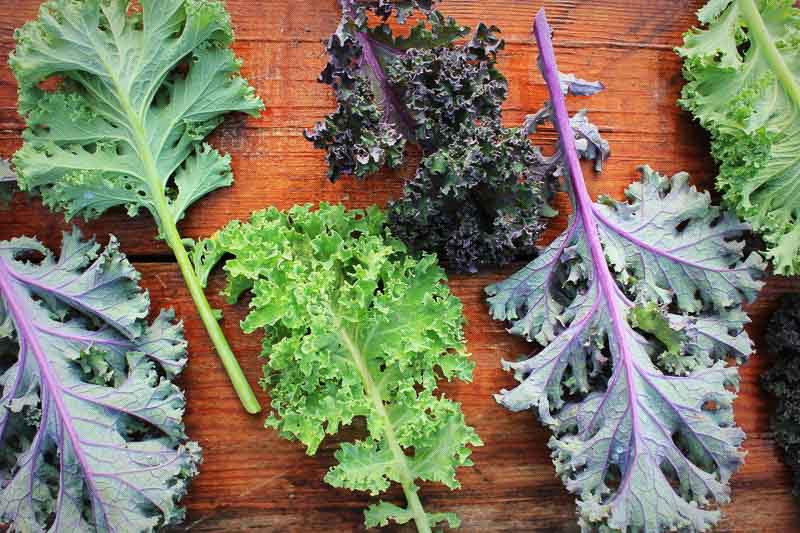
There are several types of kale, each with unique textures, flavors, and culinary uses. Some of the main types include:
Curly Kale: This is the most common variety found in grocery stores. It has tightly ruffled, dark green leaves and a slightly bitter taste. Curly kale is great for salads, sautés, and adding to soups and stews.
Lacinato Kale: Also known as Tuscan, Dinosaur, or Black kale, Lacinato kale has long, dark blue-green leaves with a slightly wrinkled texture. It has a milder, slightly sweeter taste compared to curly kale and is excellent in salads, pasta dishes, and sautés.
Red Russian Kale: This variety has flat, fringed leaves that are green with reddish-purple veins. It has a tender texture and a mildly sweet taste with a hint of pepper. A great variety for salads, smoothies, and light sautés.
Redbor Kale: This variety has ruffled leaves with a deep purple-red color. It’s slightly sweeter than curly kale and is often used for its ornamental value in addition to its culinary uses. This variety is suitable for salads, sautés, and soups.
Siberian Kale: This type features large, flat leaves that are light green to blue-green in color. It has a tender texture and a mild, sweet taste. It is well-suited for salads, smoothies, and sautés.
Ornamental Kale: While not a variety for culinary use, ornamental kale is grown for its colorful, decorative leaves. It is not typically consumed due to its bitter taste but adds beauty to gardens and landscapes.
Ornamental kale, also known as flowering kale, is a decorative plant with colorful, textured leaves that brighten up gardens and landscapes. While it is a relative of the edible kale, ornamental kale is grown primarily for its aesthetic appeal rather than its nutritional value. The foliage comes in a variety of colors, including purple, pink, white, and green, and its ruffled leaves create an eye-catching, ornamental display. It is a cool-season plant, thriving in the fall and early spring, and can withstand frost, making it a versatile choice for adding color and texture to your garden.
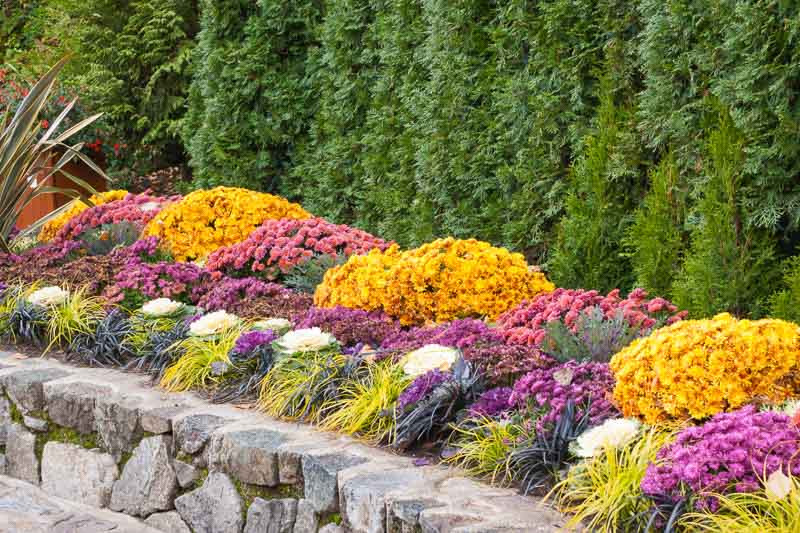 Ornamental Kale and Chrysanthemum
Ornamental Kale and Chrysanthemum
Kale is a highly nutritious vegetable that is packed with vitamins, minerals, and other beneficial compounds. Here is a breakdown of the nutritional content of kale per 100g of raw, chopped kale:
Calories: 49
Vitamins and Minerals:
*Percent Daily Values (DV) are based on a 2,000-calorie diet.
In addition to these nutrients, kale also contains various antioxidants, such as beta-carotene, lutein, and zeaxanthin, which are known to help protect the body against oxidative stress and inflammation. It is also a source of glucosinolates, sulfur-containing compounds that may have potential anti-cancer properties.
Keep in mind that cooking kale can impact its nutritional content, with some nutrients, like vitamin C, decreasing while others, like beta-carotene, becoming more available. Steaming, sautéing, or microwaving kale can help retain more of its nutritional value compared to boiling.
Kale is a nutrient-dense food that offers several health benefits. Some of the key health benefits include:
Rich in antioxidants: Kale is high in antioxidants like vitamin C, beta-carotene, quercetin, and kaempferol. Antioxidants help neutralize free radicals, which can cause oxidative stress and contribute to aging and various diseases.
Anti-inflammatory properties: Kale contains high levels of vitamin K, which has been linked to reducing inflammation in the body. Inflammation is a contributing factor to many chronic diseases, such as heart disease and cancer.
Supports heart health: Kale is a good source of potassium and magnesium, which are essential for maintaining healthy blood pressure. It also contains fiber, which can help lower cholesterol levels and reduce the risk of heart disease.
Supports eye health: Kale is rich in lutein and zeaxanthin, two carotenoids that have been shown to reduce the risk of age-related macular degeneration and cataracts.
Enhances bone health: Kale provides a good amount of calcium and vitamin K, which are important for maintaining strong bones and preventing osteoporosis.
Supports digestive health: The fiber content in kale promotes healthy digestion and helps prevent constipation.
Boosts immune system: The high vitamin C content in kale helps support a healthy immune system, which can protect against infections and illnesses.
Aids in detoxification: Kale contains compounds called glucosinolates, which are converted into isothiocyanates during digestion. Isothiocyanates have been shown to help detoxify the body and protect against certain types of cancer.
Supports healthy skin and hair: The vitamins A and C in kale are essential for maintaining healthy skin and hair. Vitamin A is needed for cell growth and repair, while vitamin C is necessary for collagen production.
Weight management: Kale is low in calories and high in fiber, making it a filling and nutrient-dense food that can help with weight management.
Incorporating kale into a balanced diet can help you take advantage of its many health benefits. Remember to consume a variety of fruits, vegetables, and other whole foods for optimal health and well-being.
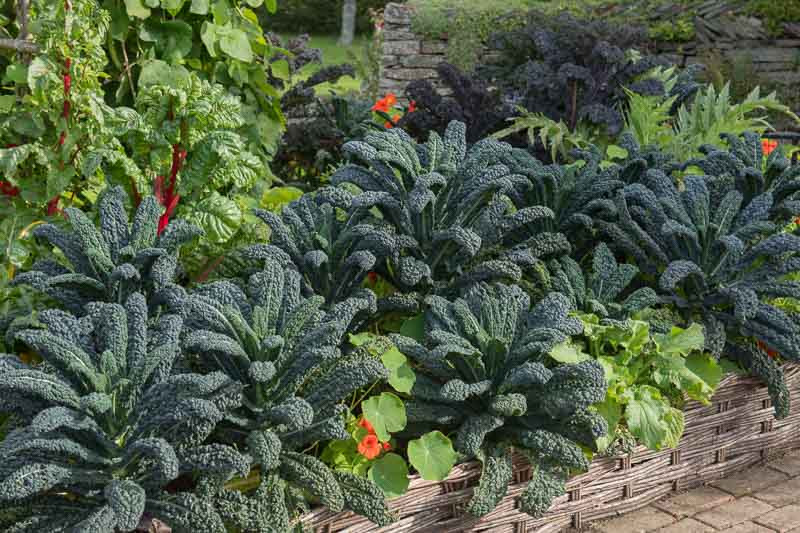 Kale ‘Nero di Toscana’
Kale ‘Nero di Toscana’
Kale is a versatile vegetable that can be used in various dishes and enjoyed in different ways. Here are some ideas on how to use it in your meals:
Salads: Remove the tough stems and tear the leaves into bite-sized pieces. You can massage the leaves with a bit of olive oil and salt to soften them, then toss them with your favorite salad ingredients and dressing.
Smoothies: Blend with fruits like bananas, berries, or mangoes, along with a liquid base like water, milk, or yogurt, to make a nutritious green smoothie.
Soups and stews: Add chopped kale to soups or stews during the last 5-10 minutes of cooking so it wilts but retains some texture.
Sautéed: Sauté kale in olive oil with garlic, red pepper flakes, and a pinch of salt for a simple side dish. You can also add other vegetables, like onions or bell peppers, for more variety.
Steamed: Steam for about 5 minutes until tender, then season with salt, pepper, and a splash of lemon juice or vinegar.
Baked or roasted: Make kale chips by tossing the leaves with a little oil, salt, and your choice of seasonings, then bake at 300°F (150°C) for 10-15 minutes or until crisp.
Stir-fries: Add chopped kale to stir-fries along with other vegetables and protein, like tofu, chicken, or shrimp.
Pasta dishes: Incorporate into pasta dishes, like lasagna or pasta bakes, or toss it with cooked pasta, olive oil, garlic, and grated Parmesan cheese for a simple meal.
Grain bowls: Combine with cooked grains like quinoa or brown rice, along with other vegetables, protein, and a flavorful dressing for a satisfying grain bowl.
Omelets and frittatas: Add chopped kale to omelets or frittatas, along with other ingredients like cheese, mushrooms, or tomatoes.
Sandwiches and wraps: Use kale leaves as a substitute for lettuce in sandwiches or wraps, or add it as a topping for extra nutrition and texture.
Remember to wash kale thoroughly before using it to remove dirt and any pesticide residues. It’s also a good idea to remove the tough stems before cooking, as they can be fibrous and difficult to chew.
Kale can be cooked in various ways, each offering a different texture and flavor. Here are some common methods for cooking it:
Sautéing: Heat a bit of oil in a large skillet over medium heat. Add minced garlic or onion, if desired, and cook for a minute or two. Add chopped kale, a pinch of salt, and a small amount of water or broth. Cook, stirring occasionally, until the kale is wilted and tender, about 5-7 minutes. Finish with a squeeze of lemon juice, a drizzle of balsamic vinegar, or a sprinkle of red pepper flakes for added flavor.
Steaming: Place chopped kale in a steamer basket over a pot of boiling water. Cover and steam for about 5 minutes or until the kale is tender but still vibrant green. Season with salt, pepper, and a splash of lemon juice or vinegar.
Boiling: Bring a large pot of salted water to a boil. Add chopped kale and cook for 3-5 minutes or until tender. Drain and season with salt, pepper, and a drizzle of olive oil. Boiling can result in a loss of some nutrients, so it’s not the most preferred method for cooking kale.
Braising: In a large pot or Dutch oven, heat a bit of oil over medium heat. Add garlic, onion, or other aromatics and cook until fragrant. Add chopped kale, a pinch of salt, and enough broth or water to cover the bottom of the pot. Bring to a simmer, cover, and cook for 20-30 minutes or until the kale is tender and has absorbed the liquid’s flavor.
Roasting: Preheat the oven to 400°F (200°C). Toss chopped kale with a little oil, salt, and your choice of seasonings. Spread the kale on a baking sheet in a single layer and roast for 10-15 minutes, stirring once or twice, until the edges are crisp and slightly browned.
Making kale chips: Preheat the oven to 300°F (150°C). Remove the tough stems from the kale and tear the leaves into bite-sized pieces. Toss with a small amount of oil, salt, and your choice of seasonings. Spread the leaves on a baking sheet in a single layer and bake for 10-15 minutes or until crisp.
Adding to soups and stews: Stir chopped kale into soups or stews during the last 5-10 minutes of cooking to allow the leaves to wilt and soften.
Remember to wash kale thoroughly and remove the tough stems before cooking. Experiment with different cooking methods to find the texture and flavor you enjoy the most.
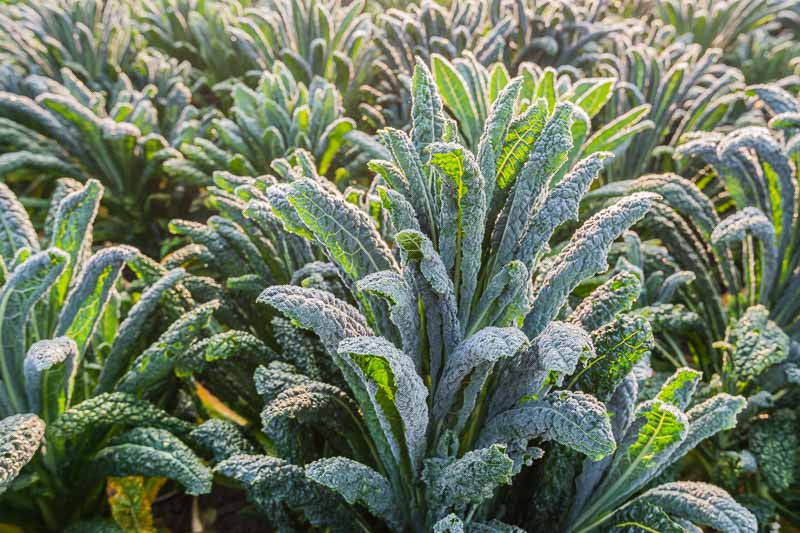 Cavolo nero or Lacinato kale
Cavolo nero or Lacinato kale
Kale chips are a healthy and delicious snack that is easy to make at home. Here’s a simple recipe to make your own kale chips:
Ingredients:
Instructions:
Growing kale in your garden has several benefits, making it a worthwhile addition to your home garden. Here are some reasons why you should consider growing it:
Nutrient-rich: Kale is a nutrient-dense leafy green vegetable, high in vitamins A, C, and K, as well as minerals like calcium, potassium, and iron. It is also a good source of dietary fiber and antioxidants, making it a healthy addition to your diet.
Versatility: Kale can be eaten raw in salads, sautéed, added to soups or stews, blended into smoothies, or made into chips. This versatility means that you can enjoy it in various dishes throughout the year.
Cold-hardy: Kale is a cold-hardy plant, making it an excellent choice for early spring or late fall planting. It can tolerate frost and even improve in taste after a light frost, as the cold temperatures can help to break down the plant’s cell walls, making it sweeter and more tender.
Easy to grow: Kale is relatively low-maintenance and can be grown in a variety of soil types, although it prefers well-draining slightly acidic soil. It is generally pest-resistant and can be grown from seeds or transplants.
Continuous harvest: You can harvest kale leaves continuously throughout the growing season, which can extend from spring to late fall, depending on your climate. Just pick the outer leaves, and the plant will continue to produce new leaves from the center.
Attractive plant: Kale comes in various colors and textures, adding visual interest to your garden. Some varieties have curly leaves, while others have smooth leaves, and they can range in color from deep green to purple.
By growing kale in your garden, you can enjoy fresh, nutrient-rich greens throughout the year while also benefiting the environment and adding variety to your garden.
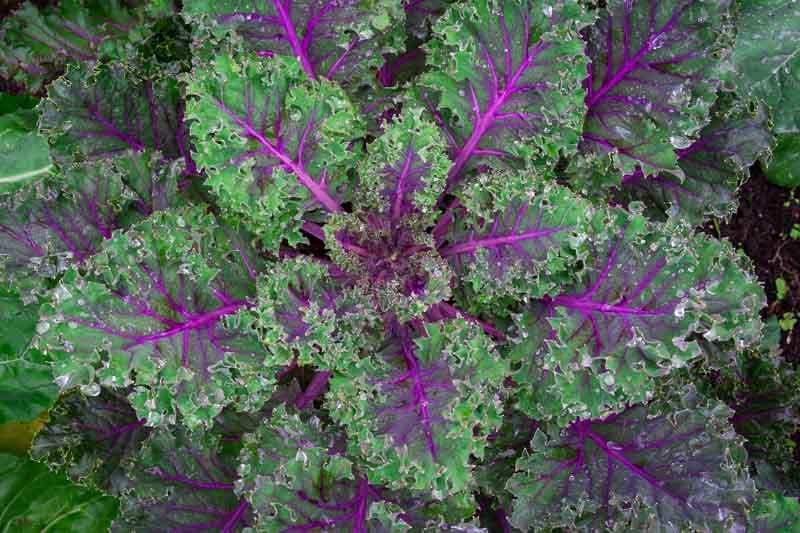
Red Russian Kale
Growing and caring for kale is relatively easy, making it an excellent choice for both beginner and experienced gardeners. Here are the steps to grow and care for this leafy green in your garden:
Choose the right variety: Select a variety that is well-suited to your local climate and growing conditions. Some popular varieties include curly kale, dinosaur (Lacinato) kale, and Red Russian kale.
Planting time: Kale can be grown in both spring and fall. For a spring crop, start seeds indoors about 6-8 weeks before the last expected frost or directly sow seeds outdoors 3-4 weeks before the last frost. For a fall crop, plant seeds three months before the first expected frost.
Sunlight: Kale prefers full sun, which means it needs at least 6 to 8 hours of direct sunlight per day. However, kale can also tolerate partial shade, particularly in warmer climates where the afternoon sun can be intense. In fact, partial shade can help to prevent the leaves from becoming too tough or bitter, especially during the hotter months.
Prepare the soil: Kale prefers well-draining, neutral soil with a pH of 6.0-7.5. Enrich the soil with compost or well-rotted manure before planting. This will provide essential nutrients and improve soil structure.
Planting: Sow seeds about ¼ to ½ inch (½-1 cm) deep and 1 inch (2.5 cm) apart in rows spaced 18-30 inches (45-75 cm) apart. If transplanting seedlings, plant them at the same depth they were growing in their containers, spacing them 12 inches (30 cm) apart in rows spaced 18-30 inches (45-75 cm) apart. Water the soil well after planting.
Germination: Seeds usually germinate within 5-10 days, depending on the soil temperature and moisture levels. Keep the soil consistently moist but not waterlogged during germination.
Thinning: Once seedlings have two sets of true leaves, thin them to one plant every 8-12 inches (20-30 cm), depending on the variety’s mature size. This will give the plants enough room to grow and ensure proper air circulation.
Watering: Keep the soil consistently moist but not soggy, watering as needed to maintain consistent moisture. Drought stress can lead to tough, bitter leaves. Adding mulch around the plants can help retain moisture and suppress weeds.
Fertilizing: Kale is a heavy feeder. Four weeks after transplanting or thinning, use a nitrogen-rich fertilizer (21-0-0) at a rate of ½ cup per 10 feet (3 meters) of row to stimulate quick plant growth. Position the fertilizer 6 inches (15 cm) away from the plants and water it into the soil to ensure proper absorption..
By following these steps, you can successfully grow and care for kale in your garden, providing you with a nutritious and versatile vegetable to enjoy throughout the year.
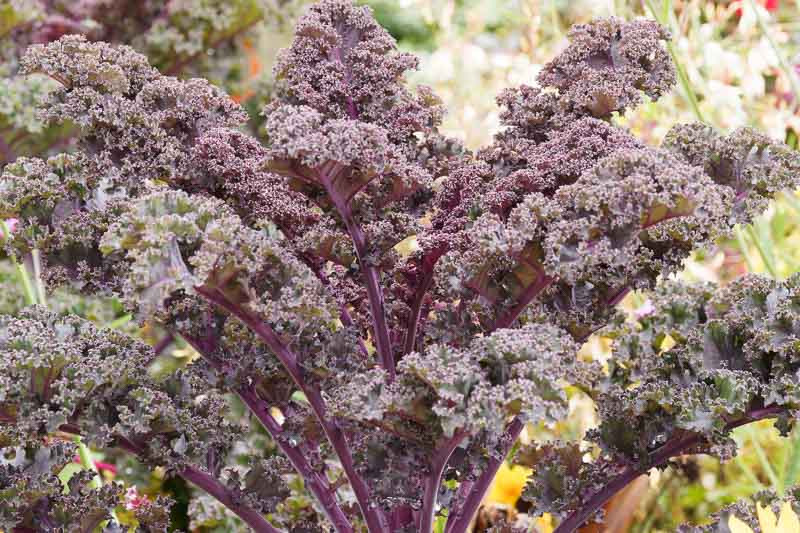 Redbor Kale
Redbor Kale
Kale is typically propagated through seeds, but you can also propagate it through stem cuttings. Here’s a step-by-step guide using both methods:
Both methods are effective for propagating kale, but growing from seeds is more common as it generally produces more consistent results and allows for a larger number of plants.
Kale, like other members of the brassica family, is susceptible to several pests and diseases. Being aware of these issues and taking preventive measures can help ensure a healthy crop. Here are some common pests and diseases:
Aphids: These tiny insects suck the sap from the leaves, causing yellowing and curling. They can also transmit viruses. Control aphids by spraying with insecticidal soap, neem oil, or introducing beneficial insects like ladybugs.
Cabbage loopers: These green caterpillars feed on the leaves, creating holes and damaging the plant. Handpick them from the plants or use a biological control like Bacillus thuringiensis (Bt), a naturally occurring soil bacterium that targets caterpillars.
Cabbage worms: Small green caterpillars that feed on the leaves, causing holes and damage. Similar to cabbage loopers, control them with handpicking or using Bt.
Flea beetles: These small beetles chew tiny holes in the leaves, which can stunt the plant’s growth. Use floating row covers to prevent them from reaching the plants or apply neem oil or diatomaceous earth to control their population.
Slugs and Snails: These pests feed on the leaves during the night, leaving large irregular holes. Use beer traps, handpicking, copper tape, or diatomaceous earth to control their population.
Clubroot: A soil-borne disease that causes swollen, distorted roots and wilting plants. Prevent clubroot by rotating crops, maintaining a slightly alkaline soil pH, and sanitizing tools and equipment.
Black rot: A bacterial disease that causes V-shaped yellow lesions on the leaf edges, eventually turning black and killing the leaves. Control black rot by practicing good sanitation, crop rotation, and using disease-resistant varieties.
Downy mildew: A fungal disease that causes yellow spots on the upper leaf surface and a white, fuzzy growth on the underside. Improve air circulation, reduce leaf wetness, and apply a fungicide labeled for downy mildew control if needed.
Powdery mildew: A fungal disease that causes a white, powdery growth on the leaves. Increase air circulation, reduce leaf wetness, and apply a fungicide labeled for powdery mildew control if needed.
Prevention is key when dealing with pests and diseases. Practice good garden hygiene, rotate crops, use disease-resistant varieties, and encourage beneficial insects to help maintain a healthy crop. Always follow the label instructions for any pesticides or fungicides used in your garden.
Can dogs eat kale?
Yes, dogs can eat kale in moderation. This is a nutritious leafy green vegetable that contains vitamins, minerals, and antioxidants, which can be beneficial for your dog’s overall health. However, it’s essential to prepare it properly for dogs by removing any thick stems and thoroughly washing the leaves to remove dirt and pesticides. Also, cook it by steaming or boiling it, as raw kale can be hard for dogs to digest and may cause gas or stomach upset. Always introduce new foods gradually and observe your dog for any adverse reactions.
Is kale good for you?
Yes, kale is good for you. This is a nutrient-dense leafy green vegetable packed with vitamins A, C, and K, as well as minerals like calcium, potassium, and magnesium. It is also rich in antioxidants and fiber, which can contribute to a healthy digestive system, lower cholesterol levels, and reduce the risk of chronic diseases like heart disease and cancer. It is a versatile ingredient that can be added to various dishes, including salads, smoothies, soups, and stews.
Can you freeze kale?
Yes, you can freeze kale. Freezing is a great way to preserve the nutritional content and freshness of kale for later use. To freeze it, first, wash and dry the leaves thoroughly. Remove any tough stems and chop the leaves into desired sizes. Blanch the kale by boiling it for 2 minutes, then quickly transferring it to an ice water bath to stop the cooking process. Drain and pat it dry with a clean towel. Place in a single layer on a baking sheet and freeze it for a few hours. Once frozen, transfer to freezer bags or airtight containers, removing as much air as possible to prevent freezer burn. Frozen kale can be stored for up to 12 months.
| Hardiness |
2 - 11 |
|---|---|
| Climate Zones | 1, 1A, 1B, 2, 2A, 2B, 3, 3A, 3B, 4, 5, 6, 7, 8, 9, 10, 11, 12, 13, 14, 15, 16, 17, 18, 19, 20, 21, 22, 23, 24, A1, A2, A3, H1, H2 |
| Plant Type | Annuals |
| Plant Family | Brassicaceae |
| Exposure | Full Sun |
| Season of Interest |
Spring (Late) Summer (Early, Late) Fall |
| Height |
1' - 2' (30cm - 60cm) |
| Spread |
1' - 2' (30cm - 60cm) |
| Spacing |
12" - 18" (30cm - 50cm) |
| Maintenance | Low |
| Water Needs | Average |
| Soil Type | Chalk, Clay, Loam, Sand |
| Soil pH | Alkaline, Neutral |
| Soil Drainage | Moist but Well-Drained, Well-Drained |
Carsten Medom Madsen, SGuillory, Peter Turner Photography, Ruud Morijn Photographer, vaivirga, Michael Schoonover, MacBen, Shutterstock
| Hardiness |
2 - 11 |
|---|---|
| Climate Zones | 1, 1A, 1B, 2, 2A, 2B, 3, 3A, 3B, 4, 5, 6, 7, 8, 9, 10, 11, 12, 13, 14, 15, 16, 17, 18, 19, 20, 21, 22, 23, 24, A1, A2, A3, H1, H2 |
| Plant Type | Annuals |
| Plant Family | Brassicaceae |
| Exposure | Full Sun |
| Season of Interest |
Spring (Late) Summer (Early, Late) Fall |
| Height |
1' - 2' (30cm - 60cm) |
| Spread |
1' - 2' (30cm - 60cm) |
| Spacing |
12" - 18" (30cm - 50cm) |
| Maintenance | Low |
| Water Needs | Average |
| Soil Type | Chalk, Clay, Loam, Sand |
| Soil pH | Alkaline, Neutral |
| Soil Drainage | Moist but Well-Drained, Well-Drained |
How many Brassica oleracea Acephala Group (Kale) do I need for my garden?
| Plant | Quantity | |
|---|---|---|
| Brassica oleracea Acephala Group (Kale) | N/A | Buy Plants |
Create a membership account to save your garden designs and to view them on any device.
Becoming a contributing member of Gardenia is easy and can be done in just a few minutes. If you provide us with your name, email address and the payment of a modest $25 annual membership fee, you will become a full member, enabling you to design and save up to 25 of your garden design ideas.
Join now and start creating your dream garden!
Create a membership account to save your garden designs and to view them on any device.
Becoming a contributing member of Gardenia is easy and can be done in just a few minutes. If you provide us with your name, email address and the payment of a modest $25 annual membership fee, you will become a full member, enabling you to design and save up to 25 of your garden design ideas.
Join now and start creating your dream garden!